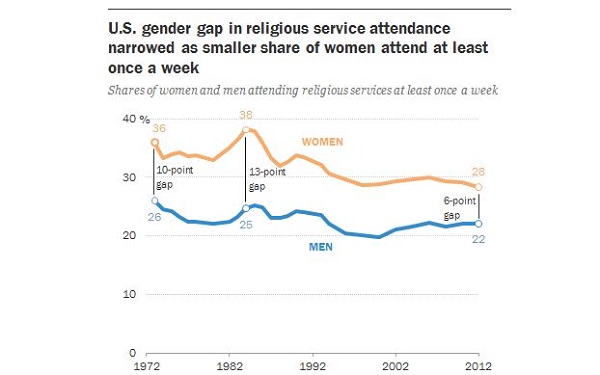
Educated Women and Working Women are Less Inclined to Attend Religious Services
- By Elisa Meyer --
- 29 May 2016 --

Historically, women attend religious services more than men, but the margin of difference is declining.
In the majority of Christian dominated countries in the world women regularly attend religious services more than men. According to a recent Pew Research Center analysis of data from the General Social Survey (GSS), in the number of United States women attending church services on a regular basis has been declining in recent decades. The early 1970s saw an average of 26 percent of men, and 36 percent of women attending regular religious services at least once a week. The mid-1980s saw a 10 percent point gap widening to 13 percent. The late-1980s though, saw the point gap shrinking, as a result of a dip in the total number of women attending religious ceremonies on a regular basis. The fact is that a good percentage of Americans in general, irrespective of gender, stopped attending Church mass/other religious services regularly by the late 80s, American women more so.
Educated Women and Working Women are Less Inclined to Attend Religious Services[/tweetthis]
The early-2010s saw the point gap coming down to just 6 percent. Based on the report, only 22 percent of the men and 28 percent the of women who participated in the survey reported of attending regular Church services.
Christian American women getting more educated, and pursuing an active and ambitious career life are two of the reasons cited for this gradual decline of their absence from regular Church services. The mid-1970s saw 3 in 10 American women within the age group of 25 to 64 working full-time jobs. As of now, 50 percent of women in that age group work full time.
Gender gap in religious service attendance has narrowed in U.S. | Pew Research Center https://t.co/6pVnutaiob
— Brian Madison Jones (@ThisDrJones) May 13, 2016
The late 1970s and early 1980s saw the fastest increase in women’s full-time employment. The point to note here is that the gender gap on religious service attendance during this time actually widened. However, by mid-1980s and late 1990s, it declined.
It is also worth noting that the 1990s saw a number of American adults becoming religiously unaffiliated. In fact, from the 90s till now, the number of religiously unaffiliated adults has doubled. According to the report, the rate of growth of unaffiliated American women has been slightly faster than unaffiliated American men. This also contributed to the fact about the gender gap in Church attendance getting smaller.
The report also states that the religiously-affiliated American men's patterns of Church service attendance have been stable over the years. If anything, it has gone up. The mid-1990s saw only about 24 percent of American men attending Church services on a regular basis. The current decade is seeing an increase of 28 percent in the statistics.





















